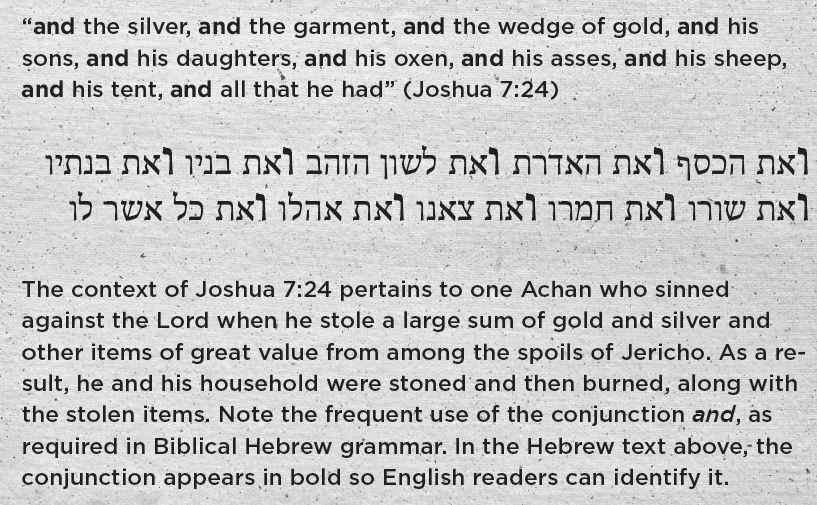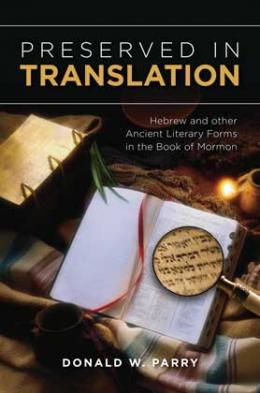Repetition of "And"
Donald W. Perry, “Repetition of And,” in Preserved in Translation: Hebrew and Other Ancient Literary Forms in the Book of Mormon (Provo, UT: Religious Studies Center, Brigham Young University; Salt Lake City: Deseret Book), 69‒72.
"and their wars, and contentions" (Helaman 3:14)
The frequent use of and in the Hebrew Bible is unlike its use in nineteenth- and twentieth-century English texts.[1] In fact, and (waw in Biblical Hebrew) is the most common word in the Hebrew Bible, occurring an astonishing 50,524 times, representing about 12 percent of all the words in the Hebrew Bible. Translators of the Bible occasionally omit the more superfluous instances of and in their translations.
Joshua 7:24 is an excellent example, with thirteen instances of and: “And Joshua, and all Israel with him, took Achan the son of Zerah, and the silver, and the garment, and the wedge of gold, and his sons, and his daughters, and his oxen, and his asses, and his sheep, and his tent, and all that he had: and they brought them unto the valley of Achor.” Conventional English gets by with only four ands: “And Joshua, with all Israel, took Achan the son of Zerah, and the silver, the garment, the wedge of gold, his sons, daughters, oxen, asses, sheep, tent, and all that he had: and they brought them unto the valley of Achor.”

In many ways, Book of Mormon usage of and matches that of the Old Testament.[2] The Book of Mormon has 16,349 occurrences of and, about 13 percent of all the words therein. We have an example of this Hebraic usage in Helaman 3:14:
But behold, a hundredth part of the proceedings of this people, yea, the account of the Lamanites and of the Nephites, and their wars, and contentions, and dissensions, and their preaching, and their prophecies, and their shipping and their building of ships, and their building of temples, and of synagogues and their sanctuaries, and their righteousness, and their wickedness, and their murders, and their robbings, and their plundering, and all manner of abominations and whoredoms, cannot be contained in this work.
The Book of Mormon has many other examples of this usage. First Nephi 11:30–32, which describes Nephi’s vision of the Lamb of God ministering among his people, has twenty-two ands; 1 Nephi 12:4, part of Nephi’s vision of things to come, contains twelve ands; Mosiah 10:8 contains eight ands in a list of weapons; Helaman 1:14 has nine ands in another list of weapons; and Alma 46:12–13 contains fifteen ands in a description of Moroni and his title of liberty.
Some original instances of and in the Book of Mormon manuscripts were removed in printed editions of the Book of Mormon to provide a better idiomatic English translation. The extra ands were good Hebrew, but as will be seen below, they can be jarring in English.[3]
“if he should command me that I should say unto this water: be thou earth and it shall be earth” (1 Nephi 17:50; and in the original manuscript was removed for the printed editions)
“and thus if ye shall say unto this temple: it shall be rent in twain and it shall be done” (Helaman 10:8; and in the printer’s manuscript was removed for the printed editions)
“that perhaps I might discover my family also and I beheld a river of water” (1 Nephi 8:13; and was removed in the printer’s manuscript)
“and because he speaketh flattering words unto you and he saith that all is well and then ye will not find fault with him” (Helaman 13:28; and was removed for the 1837 edition)
“and when Nephi had brought forth the records and laid them before him and he cast his eyes upon them” (3 Nephi 23:8; and was removed from printed editions)
Although the conjunctive and is a common and seemingly unimportant function word, it has a significant role in the Hebrew Bible. In fact, Hebrew waw (frequently translated as and) performs some thirty different functions.[4] For example, waw can link two words or two phrases, can be paired to mean “as well as” or “both . . . and,” can have a disjunctive meaning (translated as but), can connect a series of imperatives, can introduce the second part of a conditional clause (translated as then), and often introduces the expression “and it came to pass.” It is unfortunate that we lack a rigorous and exhaustive study of and in the Book of Mormon.
Notes
[1] See Bullinger, Figures of Speech Used in the Bible, 208–37. Tvedtnes points out that Biblical Hebrew “uses the conjunction ‘and’ (w) much more frequently than English. It is frequently used at the beginning of a sentence, even when there is no reason for linking that sentence up with the preceding sentence (in English, we use ‘and’ to link up syntactically related words, clauses, and sentences only).” Tvedtnes, “Hebraisms in the Book of Mormon: A Preliminary Survey,” 53. For the importance of and in the Hebrew Bible, see Davidson, Introductory Hebrew Grammar, 98–99; and Williams, Hebrew Syntax, 152–56.
[2] For a brief treatment of and in the Old Testament and the Book of Mormon, see Parry, Poetic Parallelisms in the Book of Mormon, xxxvi–xxxvii; and “Hebraisms and Other Ancient Peculiarities,” 177–78.
[3] Examples are taken from Skousen, History of the Text of the Book of Mormon: Part 1, 362–63.
[4] Koehler and Baumgartner, Hebrew and Aramaic Lexicon of the Old Testament, 257–59.
